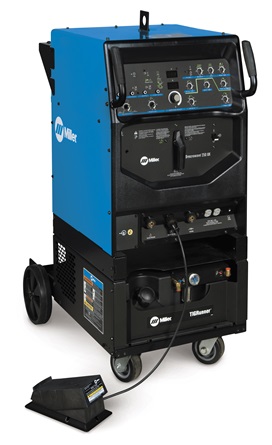Difference between revisions of "TIG Welder"
| Line 25: | Line 25: | ||
| − | Here is an example of | + | Here is an example of TIG welding and some good basic information. |
{{#evu:https://www.youtube.com/watch?v=IfJG4cMhIOc&list=PLhEXQudI6XCS3Rev1aaEwy0n4-68YdNTe&index=14&t=0s}} | {{#evu:https://www.youtube.com/watch?v=IfJG4cMhIOc&list=PLhEXQudI6XCS3Rev1aaEwy0n4-68YdNTe&index=14&t=0s}} | ||
| − | |||
==Documentation== | ==Documentation== | ||
Revision as of 16:29, 6 May 2020
The current Ace of the TIG Welder is Wyatt Bertis (wbertis22@georgefox.edu).
Description
Here is an example of TIG welding and some good basic information.
Documentation
Terminology
- Squarewave technology was developed by Miller Electric in 1976 to improve your weld quality and make TIG (tungsten inert gas) welding easier. Miller Squarewave technology provides arc stability when welding aluminum, prevents arc rectification and eliminates tungsten erosion.
- Balance control-The balance control is adjustable to provide additional oxide removal (more cleaning) or less cleaning based on the condition of the material being welded.
- Syncro Start-This allows the choice of Soft, Standard or Hot TIG starts based on the application, lead lengths and tungsten size.
- Digital welding meters-Display both amperage and voltage for viewing of the actual and preset values for greater accuracy and repeatability in your welding procedure.
- Last procedure recall-Simplifies changing your Syncrowave back and forth from aluminum TIG to stainless TIG to Stick welding. One switch makes all the control panel changes.
- Adaptive Hot Start-Stick welding features such as Adaptive Hot Start™ provide good arc strikes without sticking. Once welding, the DIG control makes dynamic adjustments to the welder to ensure smooth E7018 and deep penetration E6010.
Training
Operation
The SawStop table saw has a unique safety feature. A spring loaded cartridge is located in the machine. Any conductive material that makes contact with the blade causes the aluminum cartridge block to fire into the blade. The blade then stops spinning and drops down out of the way. All this happens within 5 milliseconds, helping to ensure the blade inflicts minimal damage. This galvanic response safety mechanism is great for preventing injuries but will permanently damage the blade if triggered. If the material you are cutting is conductive it will trigger the saw stop feature. Do not cut any wet lumber, pressure treated, or metal coated materials such as gold leaf with this machine. Charcoal is also conductive so any laser cut areas of lumber should not make contact with the blade while cutting. There are a few other things to keep in mind regarding your material as well. Make sure the material you are cutting is free of all foreign objects. Do not cut materials that may have nails or screws as they will damage the blade and may cause injury to you. Also, if the material contains a loose knot it can break free and create a safety hazard.
If your material looks good, the next step is to set up the saw itself. When setting up the saw the blade, it should protrude no more than 1/4" above the material top. This limits the amount of blade that is exposed and makes for a good cut. You will also want to hook up the adjacent dust collector to the rear of the machine, make sure it is plugged in, and turned on. The dust collector must be used with the table saw to help keep the dust out of the air. As you make a cut, it is imperative that you keep the wood firmly against the fence to make the cut square. Therefore, you should double check to see if you are reading the right measurement on the fence, especially because the fence can be moved to either side of the blade which is why there are two distance indicators, only one of which is correct for each set up. Make sure to ask the supervisor about the available jigs because they can be helpful for specialty cuts. Once the supervisor has demonstrated the use of a jig feel free to use it in the future but do not play around with jigs you are unfamiliar with.
After the saw is set up you are ready to cut. Turn on the saw and slowly push the material through, making sure to keep your hands away from the blade. Do not stop pushing the material until after the cut is finished unless there is an emergency, in which case, carefully use one hand or your hip to bump the off switch. Also not let go of your work piece during the cut or it will be forced back towards you.
Demonstration
Demonstrate you can safely setup the saw and rip a board. You will then proceed to cross cut one of the remaining pieces. Remember to set the blade height so it is protruding less than 1/8" out the top of material for less exposure. When performing a rip cut the fence is used to guide the lumber into the blade. You want to make sure that the distance between the fence and blade is the width of desired cut. Mark the edge of the material when doing a cross cut so you can align the material with the blade in the sled. You can also use a miter gauge for making cross cuts but make sure the material is long enough and well supported.
General Procedure
- Place the fume hood over the area you will be welding
- Select electrode that is adequate for your application of material
- Grind electrode to a point. (This gives a smaller and more directed arc)
- Insert the electrode into the collet of the torch
- Attach ground clamp to table (ensure ground contact surface is clean)
- Ensure the adjusting screw on the tank regulator is loose (Do not unscrew all the way)
- Open cylinder valve all the way
- Turn the adjusting screw (clockwise) to increase pressure to 15 CFH.
- Identify material type, and thickness that is going to be welded
- Refer to TIG welding chart for specified adjustments, specific to your application
- Clean material to remove any oxidizing and or oil residue
- Turn on the welder and adjust----------
- Hold the electrode in your dominant hand (ensure it can move freely)
- Hold electrode about an inch away from the metal
- Using the foot pedal to control the voltage, start off with the foot pedal half way down to start a puddle on the material.
- Once a puddle is started let off the foot pedal to maintain a steady puddle without burning through the material.
- Once the puddle is formed, dab the filler rod into the puddle
- Moving along the material, walk the electrode back and forth across the puddle while dabbing the filler into the pool
- Shutting down:
- Close gas cylinder valve
- Back out adjusting screw on regulator (Do Not unscrew all the way)
- Turn off the welder
- Remove ground clamp
Safety
- Don't exceed gas pressure past specified value
- Don't weld with gas off
- Don't touch tip to welding surface
- Don't weld in wet gear or standing water
- Don't unscrew valve adjusting screw all the way out
- Make sure ground clamp is connected to work
Certification
Troubleshooting
If the blade appears to need sharpening ask the tech to change out the blade.
A sign of a dull blade is as follows:
1. Burning of material
2. More resistance when cutting
3. Rough cut edges
4. Increased cutting noise
5. Increased motor noise
Maintenance
General maintenance
Keep the saw clean and use the dust collector. There are several lubrication points on the saw that need to be checked by the tech.
Specific Maintenance Tasks
| Maintenance Procedure | Frequency | Done By |
|---|---|---|
| Lubricate mechanisms | Semester | Sample |
| Clean machine interior | Monthly | Tech |
| Change the blade | As Needed | Tech |

